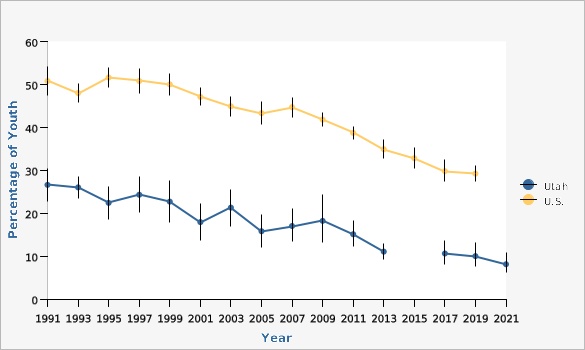Why Is This Important?
According to the U.S. Public Health Service, "Health risk behaviors that contribute to the leading causes of illness, death, and social problems among youth and adults often are established during youth, extend into adulthood, and are interrelated."^1^[[br]]
[[br]]
----
1. U.S. Department of Health and Human Services. ''Healthy People 2010.'' 2nd ed. With Understanding and Improving Health and Objectives for Improving Health. 2 vols. Washington, DC: U.S. Government Printing Office, November 2000. P. 26-20.Percentage of Students Who Used an Illegal Substance on One or More of the Past 30 Days: Alcohol, Utah and U.S., 1991-2021 |
Data Sources
- The Utah Department of Health and Human Services Youth Risk Behavior Surveillance System (YRBSS)
- Youth Risk Behavior Surveillance System, US Department of Health and Human Services Centers for Disease Control, and Prevention (CDC)
Data Notes
High school students only. Alcohol use was defined as at least one drink of alcohol.
Question text: During the past 30 days, on how many days did you have at least one drink of alcohol?How Are We Doing?
Alcohol (8.1%) and marijuana (7.8%) were the most commonly abused substances among adolescents in grades 9-12 in Utah, 2021 from the Youth Risk Behavior (YRBS) survey. SHARP data showed a rate of current alcohol use of 5.3% and a rate of current marijuana use of 5.9% Statewide in 2021 in grades 8, 10, and 12.
In 2021,Southeast (9.3%), Summit County (8.7%), and Weber-Morgan (8.7%) Local Health Districts (LHDs) had significantly higher rates of current alcohol use than the state while Utah County (3.0%), and Davis County (4.3%) LHDs had lower rates.
Also in 2021, Southeast (11.3%), Weber-Morgan (8.2%), and Salt Lake County (7.3%) LHDs had a significantly higher rate of current marijuana use than the state while Central (4.0%), and Utah County (3.7%) LHDs had lower rates.What Is Being Done?
According to the U.S. Public Health Service, "Adopting a multicomponent approach to youth substance abuse prevention may increase the long-term effectiveness of prevention efforts. This approach includes focusing on mobilizing and leveraging resources, raising public awareness, and countering pro-use messages. Several strategies may be effective, such as increasing the involvement of parents and parent groups at the local level, increasing the number of adult volunteers involved in drug prevention at the local level, changing normative attitudes among youth from 'everyone's using drugs' to 'everyone has better things to do than drugs,' and increasing the proportion of youth participating in positive skill-building activities."^1^[[br]]
[[br]]
----
1. U.S. Department of Health and Human Services. ''Healthy People 2010.'' 2nd ed. With Understanding and Improving Health and Objectives for Improving Health. 2 vols. Washington, DC: U.S. Government Printing Office, November 2000. P. 26-29.Healthy People Objective: Reduce past-month use of illicit substances
U.S. Target: Not applicable, see subobjectives in this category
Date Indicator Content Last Updated: 10/20/2022
Other Views
- Alcohol, Utah and U.S., 1991-2021
- Alcohol, Grades 8, 10, and 12 by Local Health District, Utah, 2021
- Marijuana, Utah and U.S., 1991-2021
- Marijuana, Grades 8, 10 and 12 by Local Health District, Utah, 2021
- Binge Drinking During the Past 30 Days by State, 2019

